When grubs hit hard, forage supplies dwindle fast! Stand loss in hay fields and pastures due to grub damage is becoming more common. Warm open falls and warm springs are ideal for grub feeding activity. (Figure 1) The result is a thin, weedy stand with low yields , and poor resistance to drought. Grubs prefer feeding on grass root systems over legumes. They also prefer lighter textured soils. Unfortunately, control options are non-existent, other than rotation to a less susceptible crop.
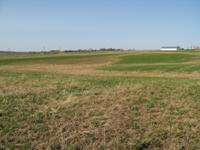 Figure 1. Grub damage in Ontario forages, 2008
Figure 1. Grub damage in Ontario forages, 2008
Photo Credit: Robert Moloney, FS Partners
Which Type Of Grub?
Though the most common grub in field crops is European chafer, other grubs can cause damage as well. It is critical to determine which grub you have and the level of infestation. Dig in the bare or dying areas of your fields and look for grubs. Examining the rasters or anal hairs at the butt end of the larvae will determine the type of grub. To more easily handle the grub either:
- cut the grub in half so that it stops squirming, leaving you with just the bottom half, or
- roll a piece of paper into a tube, let the grub crawl in, pinch the tube off so that the butt end still sticks out but the head and biting part does not.
Use a magnifying glass to get a good look at the rasters.
- If the rasters have a Y- or deep, long V-shaped pattern (like an “open zipper”), it is a European chafer grub (Figure 2a).
- If the rasters are in an oval-shaped pattern with the hairs running parallel to each other, it is a June beetle grub (Figure 2b).
- If you live in the Niagara area, you may be dealing with Japanese beetle grubs, which have short V-shaped raster patterns (Figure 2c).
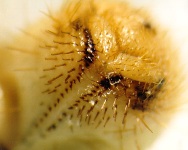 Figure 2a. European Chafer Grub – raster pattern. Note open “zipper”
Figure 2a. European Chafer Grub – raster pattern. Note open “zipper”
Photo credit: Art Schaafsma, U of G, Ridgetown Campus
 Figure 2b. June Beetle Grub Raster Pattern
Figure 2b. June Beetle Grub Raster Pattern
Photo Credit Art Schaafsma, U of G, Ridgetown Campus
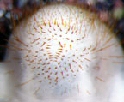 Figure 2c. Japanese beetle grub – raster pattern
Figure 2c. Japanese beetle grub – raster pattern
Different Grubs Have Different Life Cycles & Feeding Patterns
- European chafer is a one year grub (Figure 3). The larvae feed into late-fall and start feeding again in very early spring, until they pupate by mid-May. Then there is a summer break from larvae feeding. All of the feeding damage by chafer is done in late-fall and early-spring. This is why soybeans tend to escape chafer damage, because the crop is planted later and grows when the larvae are not actively feeding.
- June beetle grubs live in the soil for 3 years, making it the most troublesome. (Figure 4) Two of those years are spent as larvae that feed on the crop throughout the year. June beetle grubs can affect soybeans and most crops because the larvae are feeding all summer long, whenever the crops are growing.
- Japanese beetle grubs are common in Niagara Region. They are a one year grub similar to the European chafer, except Japanese beetle grubs feed longer into the summer before pupating. (Figure 5) Feeding damage by Japanese beetle grubs can continue until early-June, until they pupate to become adults. Feeding begins again in late-summer, after the adults have laid their eggs and the new larvae hatch and begin feeding.
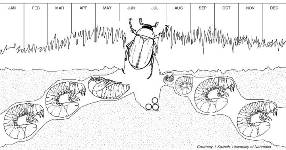 Figure 3. European Chafer – one year life cycle
Figure 3. European Chafer – one year life cycle
Source: University of Nebraska
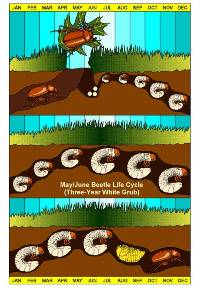 Figure 4. June Beetle cycle – live for 3 years in soil
Figure 4. June Beetle cycle – live for 3 years in soil
Source: University of Nebraska
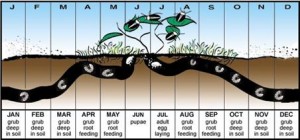 Figure 5. Japanese beetle life cycle
Figure 5. Japanese beetle life cycle
Source: University of Minnesota
Control Option – Rotate To Corn, Soybeans or Cereals?
There are no insecticides that will control grub damage in established forage crops. The best option in severely damaged fields is tillage (this exposes the grubs to predators) followed by replanting the field into a crop that has insecticide seed treatment options available (corn, soybeans, cereals). One year out of forages is required to reduce grub populations for chafer and Japanese beetle, and 3 years is usually required for June beetle control.
Neonicotinoid insecticides (Poncho, Cruiser) give protection in corn, cereals and soybeans. If you are finding 2 – 3 chafer grubs per square foot, an insecticide seed treatment is required. With very high infestations, a higher label rate of insecticide is necessary.
If your goal is to re-establish forage the following year in a field with European chafers, corn is the preferred rotation crop. Chafers will lay eggs in soybeans, but not in corn. Planting soybeans can result in grub injury to the newly seeded forage crop the following spring.
Scout for grubs again in early-fall to determine if numbers exist that require seed treatment the following spring, or a different crop to avoid injury.
Refer to the Field Crop Protection Guide, OMAFRA Publication 812.
http://www.omafra.gov.on.ca/english/crops/pub812/p812toc.html